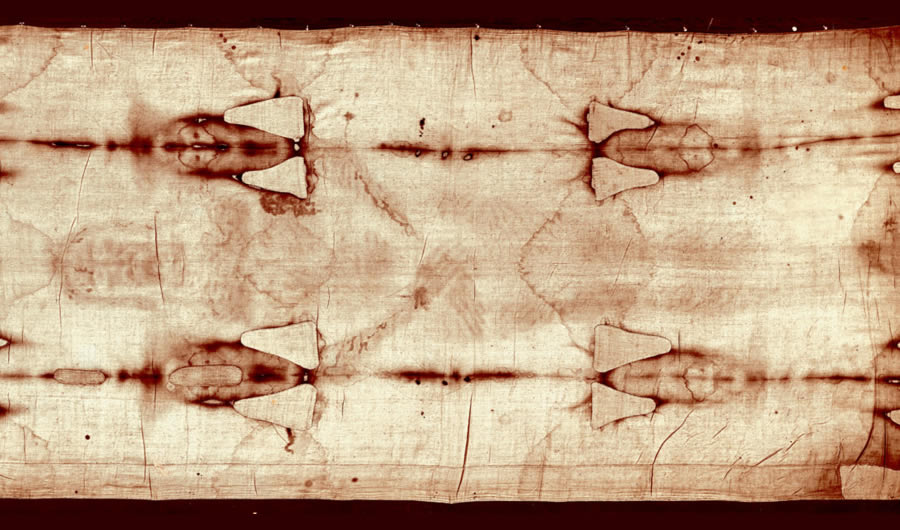The Shroud of Turin is Back in the Spotlight, Sort Of

A photo of the Shroud of Turin, taken in 1931 by Giuseppe Enrie.
In 1988, three radiocarbon labs reported with 95% confidence that the Shroud of Turin dated from sometime between 1260 and 1390 A.D. This was all the evidence that shroud skeptics needed to declare it a fraud. Science has spoken. Case closed.
But new research has upended these claims.
Contrary Evidence
To many shroud researchers, the 1988 carbon dating results came as a shock. Several other lines of evidence had pointed to its authenticity. The scourge marks and blood stains on the shroud’s anatomically correct image of a man match the New Testament’s description of Christ’s Passion. The fabric contains pollen from Europe and the Middle East, and small bits of fibrils of a Middle Eastern species of cotton not found in Europe. The 1978 STURP investigation demonstrated that the faint image on the linen was not painted on. If a medieval artist did produce the image on the shroud, his methods are lost to history.
The special qualities of the shroud were revealed to the world in dramatic fashion in 1898 when Secondo Pia took the first photograph of it. When he developed the first plate he almost dropped it from the shock of seeing the face of the man on the shroud on the negative, as if it were a positive image! The imagined medieval artist would have had to anticipate photography hundreds of years before it was invented.
Recent research involving non-conventional linen dating methods have also pointed to an early date, consistent with a first century origin.
More recent research continues to weaken the case for a medieval date. The Hungarian Pray Codex, dating from about 1192 A.D., very likely contains the earliest surviving depiction of the shroud. Yet, this date falls long before the earliest carbon-14 date for the shroud. Even worse for skeptics, numismatic evidence points to the shroud’s existence as early as 692 A.D.
The Shroud of Turin is not the only purported burial shroud of Jesus. Another, much smaller, one is the Sudarium of Oviedo. It is believed to be a facecloth. Its provenance is known back to 631 A.D. Several studies have compared the two cloths, finding many coincidences. This strongly suggests that the Shroud of Turin and the Sudarium of Oviedo once covered the same body. This implies that the shroud dates no later than 631 A.D.
Recent research involving non-conventional linen dating methods have also pointed to an early date, consistent with a first century origin.
Delayed Release
How do we reconcile all these facts with the reported carbon-14 date range? Well, we can look more carefully at the original study. Was the sample representative of the whole shroud? Were the results consistent? Based on studies from 2005 and 2008, the answer to the first question is “No.” The region of the shroud where the sample was extracted includes a lot of newer fabric. It had been skillfully rewoven in the 16th century to repair areas damaged by fire in 1532. The carbon-14 dating method is not at fault in this case, but rather, the way the sample was selected and prepared.
Since the 1988 carbon dating results were published, shroud researchers have been asking to see the raw data. All such requests were declined until 2017, when a French researcher used the Freedom of Information Act to obtain them from the British Museum. Tristan Casabianca and collaborators published the results of their data analysis on March 22, 2019. The final sentence from their abstract reads, “A statistical analysis of the Nature article and the raw data strongly suggests that homogeneity is lacking in the data and that the procedure should be reconsidered.” Their study supports the conclusions of shroud researchers that the sample region contains anomalies.
Two months later they presented their results at a conference at the University of Catania, Italy. The European media reported on the new findings, as one would expect, but there has been scant coverage in the U.S. One can only hope that the Vatican will allow more testing of the Shroud of Turin, including new carbon-14 testing.
Profound Implications
Each of us must decide on our own whether we find the evidence for the shroud’s authenticity convincing. For the record, I do find the evidence convincing. Still, until the carbon-14 dating controversy is resolved, I would caution against including the Shroud of Turin as part of an apologetic for Christ.
As a Presbyterian, I don’t consider the Shroud of Turin a “Catholic thing.” People with a wide range of backgrounds and beliefs have shown interest in it. Barrie Schwortz, who is Jewish, is one of the still-living 1978 STURP team members. He has been editing The Shroud of Turin Website (shroud.com) since 1996. Even atheist skeptics can’t leave the shroud alone.
Some may be concerned about worshiping graven images. But no one is suggesting that it be worshipped. Besides, if the Shroud is authentic, then the image on it was not made by human hands. It would be the witness to the resurrection, a visual love letter from the first century.
Guillermo Gonzalez is an astronomer and astrobiologist at Ball State University, and co-author (with Jay Richards) of Privileged Planet: How Our Place in the Cosmos is Designed for Discovery.


